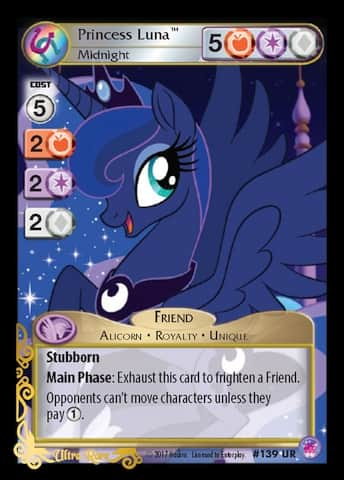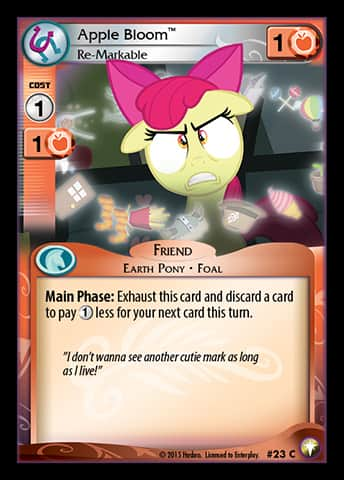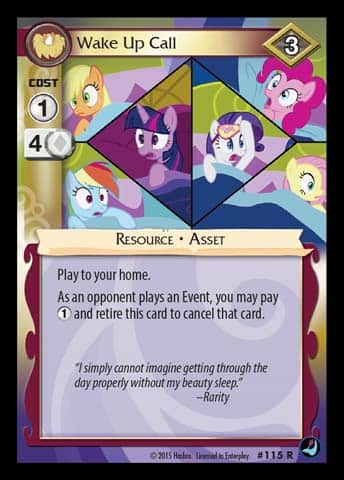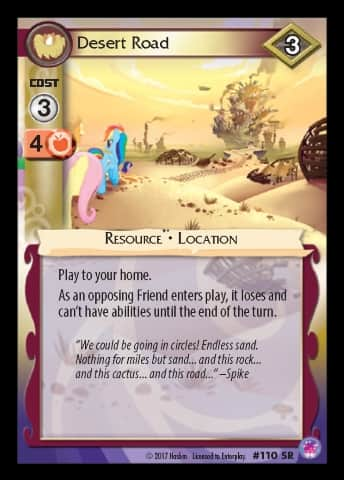Processing Actions
Last time we talked about taking actions. That post goes into details of which actions you can take when, however, there’s a bit more to taking actions than just knowing when you can do it. It is also important to know how to take an action and what happens when you do.
So this time we will fill that gap, and likely will open a whole lot of new gaps in the process.
Let’s refresh on the set actions that players can take in the game:
- Playing a card
- Performing a Main Phase action
- Activating an ability
Even though those sound very different, the steps you need to do to perform them are the same, with some very slight differences. But first, let’s talk about costs.
Costs
In MLP:CCG actions and effects can have a cost. You can’t take an action or process an effect if you can’t pay all of the costs. Costs appear in many different forms, so we’ll review each one.
1.

This card has a cost of 2
An action token number on the left of every playable card (except Troublemakers). This one is fairly simple, if you want to play a card, the number on the left of that card is the cost of taking that action.
While Troublemakers don’t have any printed cost, the cost to play them is .
2. “pay“

Pay your taxes!
If a part of the action tells you to pay something, that something is a cost. Not all of the cards with word “pay” on them imply a cost, only cards that specifically instruct you to pay do.
Here are some examples:
- “pay” is a cost: Cerberus
 , Princess Luna, Midnight
, Princess Luna, Midnight
- “pay” is not a cost: Rainbowshine, Gift Giver
 , Zomponies, Terrifying Infestation
, Zomponies, Terrifying Infestation . You can see that on
these cards “pay” is not an instruction, they just change how much a player
needs to pay for some of their actions.
. You can see that on
these cards “pay” is not an instruction, they just change how much a player
needs to pay for some of their actions.
3. “do X to do Y”

Costs are not nessesarily AT!
If part of the text has “do X to do Y”, X is a cost. For example, exhausting
and discarding a card in Apple Bloom, Re-Markable ’s ability is a cost. Retiring friend
with Minuette, Schadenfreude
’s ability is a cost. Retiring friend
with Minuette, Schadenfreude is a cost. Very important to note here that if you have a
card that has “do X to do Y” in its text, that’s not a cost for playing that
card, it’s the cost of processing it’s effect. For example, in Belly Flop
is a cost. Very important to note here that if you have a
card that has “do X to do Y” in its text, that’s not a cost for playing that
card, it’s the cost of processing it’s effect. For example, in Belly Flop retiring a friend is not a cost for playing it. We will touch more on that
very shortly.
retiring a friend is not a cost for playing it. We will touch more on that
very shortly.
4. Main Phase actions
Main Phase actions have intrinsic costs. Pay to move, pay to draw a card, pay to play a Troublemaker, etc.
Cost interactions
Now that we know what costs look like, let’s see what does it actually mean for something to be a cost.
You can’t pay a cost that can’t happen

Friends can’t leave play this turn? Hm…
This one is pretty straightforward. You can’t pay with something that don’t have
or can’t do. You can’t exhaust Princess Luna, Midnight to frighten a friend if she’s
already exhausted. You can’t play Braeburn, Two Left Hooves
to frighten a friend if she’s
already exhausted. You can’t play Braeburn, Two Left Hooves at all if you played Bats!
at all if you played Bats! earlier that turn choosing “Your Friends can’t leave play this turn.”.
earlier that turn choosing “Your Friends can’t leave play this turn.”.
Costs that are replaced can’t be paid

Oh, oh, what if I use Re-Markable…?
This one is actually fairly important and I’ve seen some players not being aware about this little thing about costs. If any relpacement modifier (“if X would happen do Y instead”) replaces the cost that you’re paying, you can’t pay that cost. Let’s dive straight into examples:
You can’t put The Fire of Friendship
 into play by discarding it to Apple Bloom, Re-Markable
into play by discarding it to Apple Bloom, Re-Markable ,
because discarding a card there is a cost, and you can’t pay for it if you
replace it.
,
because discarding a card there is a cost, and you can’t pay for it if you
replace it.If you have a Persistent Friend you can’t frighten them when you’re retiring them with Minuette, Schadenfreude
 , because retiring a Friend is a cost and if
you replace it, it can’t be paid.
, because retiring a Friend is a cost and if
you replace it, it can’t be paid.
If there are multiple costs, you have to pay them in order that allows to pay all of them
The title here is self-explanatory, but let’s still look at an example: if you have a Friend with an ability that has cost “Exhaust this card and retire a Friend” and that’s the only Friend in play, you have to exhaust it first and then retire it. Pretty straight-forward!
If there are multiple costs you have to pay all of them

Well, what if just discard a card…?
If an effect has more than one cost, you have to pay for it all. Let’s take a
look at Apple Bloom, Re-Markable . You have to both exhaust her and discard a card to
pay the cost for that ability. You can’t just do one of them and call it a day.
. You have to both exhaust her and discard a card to
pay the cost for that ability. You can’t just do one of them and call it a day.
Costs on actions and costs on effects
There’s a difference between having a cost for taking an action and a cost for processing an effect. If can’t pay the cost for taking an action, you can’t take that action at all. However, if there’s a cost on some sort of effect and you can’t pay for it, it just “fizzles”, in other words nothing happens.
Let’s look at Bale Out! and Belly Flop
and Belly Flop . In the first one, discarding
a card is a cost for playing that card. So if you for some reason can’t
discard a card (e. g. you have no cards in hand), you can’t play Bale Out!
. In the first one, discarding
a card is a cost for playing that card. So if you for some reason can’t
discard a card (e. g. you have no cards in hand), you can’t play Bale Out! . However that is not the case with Belly Flop
. However that is not the case with Belly Flop . While it does have
a cost of retiring a Friend that is a cost on its effect. You can still play the
card just fine if you have no Friends on the board (or played Bats!
. While it does have
a cost of retiring a Friend that is a cost on its effect. You can still play the
card just fine if you have no Friends on the board (or played Bats! ,
but after you start processing its effect, if you can’t pay the cost nothing
will happen.
,
but after you start processing its effect, if you can’t pay the cost nothing
will happen.
And don’t let the similarity fool you, costs on activated abilities are costs
to activate that ability, not to process its effect. So while Minuette, Schadenfreude ’s text may look similar to Belly Flop
’s text may look similar to Belly Flop ’s, you can’t activate it if
you can’t pay the cost. It’s not like you activate and it just doesn’t do
anything (like with Belly Flop
’s, you can’t activate it if
you can’t pay the cost. It’s not like you activate and it just doesn’t do
anything (like with Belly Flop ). To be fair, I couldn’t come up with an
example where this difference actually matters, but who knows what cards we
might get in the future, so I thought it’s better to not skip this bit.
). To be fair, I couldn’t come up with an
example where this difference actually matters, but who knows what cards we
might get in the future, so I thought it’s better to not skip this bit.
Costs for playing Events and copying
There’s one last thing that is noteworthy about costs. When you copy an Event,
you don’t pay costs for playing it again (because you don’t play it, you copy
it). That means if you copy Bale Out! , you won’t have to discard a card.
However, if you copy Belly Flop
, you won’t have to discard a card.
However, if you copy Belly Flop , you still have to retire a Friend, because
retiring a Friend as a cost is part of Belly Flop
, you still have to retire a Friend, because
retiring a Friend as a cost is part of Belly Flop ’s effect.
’s effect.
Another thing, that some cards have text that is referring to the cost, like
Party Hard . So when you copy it nothing will happen (in Party Hard
. So when you copy it nothing will happen (in Party Hard ’s
particular example), because you didn’t retire any Friends since you didn’t have
to pay that cost.
’s
particular example), because you didn’t retire any Friends since you didn’t have
to pay that cost.
Now that’s pretty much everything one need to know about costs. Let’s now get to taking actions!
Steps to taking an action
Taking an action is done by doing steps in a specific order. If any of those steps can’t be complete for any reason, the game state is rewound right to the moment before the first step. And, yes, I’m basically rewriting everything that is written under rule 705.2 here with some notes.
Step 1. Announce the action
After you’ve decided to take an action, the first thing you do is that you announce the action you’re going to take (playing a card, performing a Main Phase action or activating an ability). If you’re playing a card, you also have to show it.
Step 2. Determine the costs and check the color requirements
Color requirement part is fairly straight-forward and should be familiar for the most of the players, there’s nothing particularly interesting about it.
Determining the costs is fairly easy as well. We look at the cost we need to
take an action (if any), look if there are any additional costs, look if there
are any modifiers/effects affecting the cost that we need to pay (such as
Plaid Stripes, Spoony )
)
Step 3. Pay the costs
This is where you pay said costs. Whether it’s giving away some of your action tokens, or discarding a card. Note if you for any reason can’t pay all of the costs at this step (for example, one of the costs is replaced), you can’t complete this step, thus the game is rewound to right back before Step 1.
Step 4. Put the card into the Queue Zone
I don’t know how many people are aware, but we actually have a Queue Zone in the game! Funnily enough, there’s no actual queue involved because I’m fairly sure it’s impossible to have more than one card in the Queue Zone at the moment. So when the action you take is playing a card, you put that card into the Queue Zone on this step. Otherwise, skip this step.
After the card gets into the Queue Zone all “As a [palyer] plays a [card]” (like
Wake Up Call ) immediately resolve right away here. Important to note that
this happens before the card’s text is actually processed, which means that if
your opponent has a Wake Up Call
) immediately resolve right away here. Important to note that
this happens before the card’s text is actually processed, which means that if
your opponent has a Wake Up Call and you play a Song, like Luna's Future
and you play a Song, like Luna's Future ,
you don’t have to name which mode you’re choosing (or any decisions about the
card whatsoever). That is done on the next step, and “As” abilities process
before that.
,
you don’t have to name which mode you’re choosing (or any decisions about the
card whatsoever). That is done on the next step, and “As” abilities process
before that.
Step 5. Follow the instructions on the card/action/ability
This is where the magic happens! The action you’re taking comes to life. You read the text and do what it says!
If for some reason following some of the instructions can’t really be done, the game is not rewound, instead you try to follow as many instructions as you can.
After you follow the instructions, some of the following things happen:
- A Friend, Troublemaker or Resource enters play.
- Triggers that trigger off a player playing a card trigger (like Smile and Wave
 ).
). - An Event creates a modifier (normally speaking: Event does its thing) and then goes into the discard pile.
- An ability creates a modifier (does its thing)
- A Main Phase action creates a modifier (does the thing)
But this list doesn’t really show a full picture of what will happen. For instance, what does it mean for a Friend/Troublemaker/Resource to enter play? What happens when you process a Main Phase action like moving? Let’s take a look at both of them in more detail.
Cards entering play
So after you’ve played a Friend/Resource/Troublemaker it enters play. Entering play means being put from another zone into the Play Zone, also known as “put into play”.
When that happens following things happen in order:
- “As a [card] enters play” triggers are processed (like Desert Road
 ).
If there are multiple of such abilities, they’re applied in timestamp order,
meaning that whichever was in play first will be applied first (most of the
time).
).
If there are multiple of such abilities, they’re applied in timestamp order,
meaning that whichever was in play first will be applied first (most of the
time). - Everything that affects how the card enters play is applied (“enters play
frightened”, etc). Good example here would be Captain Celaeno, By the Book
 which affects
how Troublemakers enter play at her Problem.
which affects
how Troublemakers enter play at her Problem. - Then card’s continuous abilities start to work, and other cards’ continuous
abilities start to affect it. What are continuous abilities? Basically
abilities that affect the game over time, or even easier, abilities that are
not triggers and not activated abilities. For instance, if a Friend enters
play at a Problem with Trixie, Highest Level Unicorn
 , this is when it loses all of its
abilities. And this is when your characters get +2 power when Princess Twilight Sparkle, Endless Friendship
, this is when it loses all of its
abilities. And this is when your characters get +2 power when Princess Twilight Sparkle, Endless Friendship enters play. You might wonder, what happens when you have two “conflicting”
continuous abilities, like playing Iron Will, Attack the Day
enters play. You might wonder, what happens when you have two “conflicting”
continuous abilities, like playing Iron Will, Attack the Day to a problem with an
opposing Iron Will, Attack the Day
to a problem with an
opposing Iron Will, Attack the Day ? Long story short whoever was first will be applied
first (again, most of the time).
? Long story short whoever was first will be applied
first (again, most of the time). - Abilities “when a [card] enters play” trigger. This one is pretty
straightforward. I want to point out that “[card]” includes “this”, so this is
when “when this card enters play” abilities trigger as well. This is also why
Desert Road
 stops them (because it removes Friend’s abilities before this
step), and this is why playing a Friend at a problem with Trixie, Highest Level Unicorn
stops them (because it removes Friend’s abilities before this
step), and this is why playing a Friend at a problem with Trixie, Highest Level Unicorn will also not trigger their “when this card enters play” ability.
will also not trigger their “when this card enters play” ability.
Aaaand that’s it! After that, your card is officially in play! Note that the same
rules apply for cards entering play for reasons other than you taking actions,
like putting a token Friend into play, or putting a Friend back after using
Interdimensional Portal on it. This is also why using Portal on Friends with “When you
play this card” abilities doesn’t work, because those abilities trigger when you
actually play a card (which you can see in Step 5 of taking an action above).
on it. This is also why using Portal on Friends with “When you
play this card” abilities doesn’t work, because those abilities trigger when you
actually play a card (which you can see in Step 5 of taking an action above).
Moving a character
As you probably know Play Zone is split into areas. Both players have a Home area and each of the Problems in play have their own area.
Every card in Play Zone is in one of the areas. No card can be “nowhere” and no card can be in two areas at the same time. Moving is when a card goes from one area to another.
Just like entering play, to move a card you need to follow some steps in order, and they’re actually kind of similar to the “entering play” ones.
- Everything that affects how the card is moved is applied. And then the card is immediately put into the new area.
- Continious abilities of the card begin to affect the new area, and that
area’s continious abilities affect the card. This is pretty much the same as
entering play. For instance, if you move a Friend to a Problem with Trixie, Highest Level Unicorn
 this the step is where it loses all of its abilities.
this the step is where it loses all of its abilities. - “When a [card] is moved” or “When a [player] moves a [card]” are triggered. I don’t really have much to add here, this one is fairly straightforward.
And that’s it! The card has successfully moved.
Conclusion
That’s pretty much everything you need to know on how to take an action and what might happen when you do! I tried to not go too much in detail on modifiers, because they’re a very big topic on their own and go way outside of the scope of this post.
Hope you learned something new!